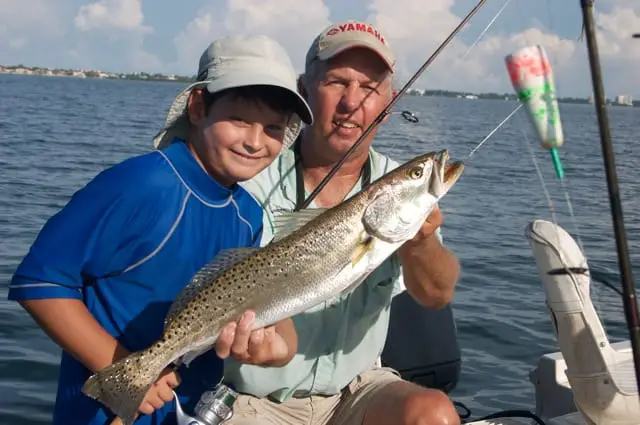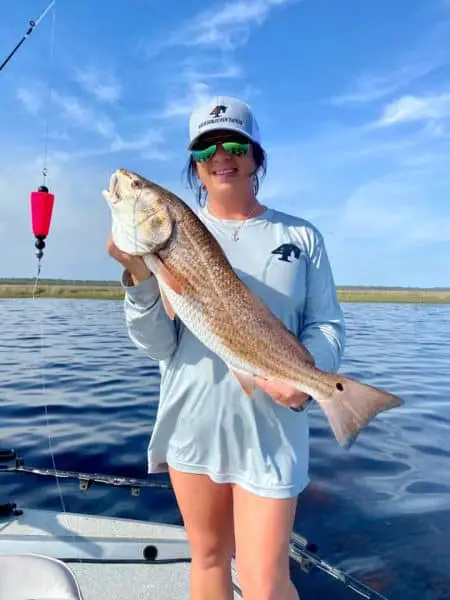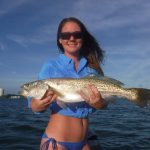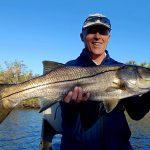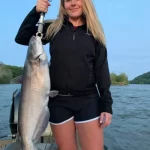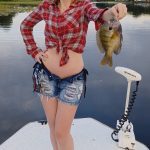Fishing with popping corks, pro tips and techniques.
This article will focus on fishing with popping corks. Popping corks are specially designed floats. They are primarily used by anglers chasing speckled trout and redfish along the coast from Texas to the mid Atlantic. However, they are effective on other species as well.
A popping cork is a noisy float. A live bait or artificial lure is suspended 2 to 3 feet below it. When twitched sharply, the popping cork puts out a distinctive sound which imitates feeding game fish. This attracts those fish to the bait or lure.
Popping cork types
There are two basic types of popping corks; fixed corks and those that can be added on to the line. Like most things, there are advantages and disadvantages to both. These two types of popping corks will be discussed below.
Slotted popping corks
The original type of popping cork were slotted units that could be easily added onto the running line. They have a slot running down the length of the cork with a plastic pin. This design makes it very easy for anglers to add or remove the popping cork as needed, as well as easily adjusting the depth at which the bait or lure is present.
These popping corks also have a concave top and most are weighted at the bottom. This results in the popping cork sitting a bit lower in the water as well as being completely vertical. This attitude of the popping cork is very important as it results in a nice loud pop when the angler twitches the rod tip. Anglers fishing with popping corks have been using these types of corks for decades with great success!
Click the link to shop Amazon for slotted popping corks
“Fishing Lido Key is a participant in the Amazon Associates Program, an affiliate advertising program designed to provide a means for sites to earn advertising fees by advertising and linking to Amazon. As an Amazon Associate I earn from qualifying purchases. ”
Fixed popping corks
Fixed popping corks have become very popular among anglers over the last decade or two. Most are fairly heavy and consist of a float, rattles, and a weight. The heavier weight of this style of popping cork allows for longer casts. They also, generally speaking, put out a lot more commotion then the pegged popping corks do. Some of these have a concave face that created a “pop”. Others are round and the beads and rattles create the noise.
Video on how to fish a popping cork
Anglers fishing with popping corks using these fixed versions must tie the cork to the running line. A leader then connects the bottom of the popping cork to the lure or hook. The one disadvantage of this type of popping cork is that the depth cannot be as easily adjusted as can be done using a pegged popping cork. They are better suited for anglers who prefer to use and artificial lure under a popping cork.
Check out the best inshore saltwater fishing tackle
There are several manufacturers that offer quality saltwater popping corks. Cajun Thunder corks are very popular and effective. Bomber Saltwater Grade popping corks work well, too.
Anglers can click the links to shop Amazon for Cajun Thunder and Bomber popping corks
Fishing with popping corks
While fishing with popping corks may seem simple and straightforward, and it really is, there are some nuances and subtle techniques that will help anglers achieve more success.
Fishing with popping corks can be productive in all water conditions. However, they really stand out when fishing in stained or dirty water conditions. The reason for this is quite obvious; when the water is dirty game fish use sound and vibration more to locate prey. Popping corks do an outstanding job of imitating game fish that are feeding on the surface.
Popping cork fishing techniques.
One great aspect of fishing with popping corks is it is extremely easy, making it a great choice for novice anglers. As mentioned above, the popping cork sits 2 to 3 feet above a live bait or artificial lure. The rig is cast out, allowed to settle, then twitched sharply. The cork will dig into the water and produce a distinctive popping sound.
Twitching the rod tip sharply causing the court to pop results into benefits. One, the sound of the cork attracts game fish to the lure or bait dangling below. Second, the twitch causes that lure or eight to jump up sharply and then flutter back down, suspending at the desired depth. Game fish find this irresistible and will often attack the offering as it hangs there motionless. When the cork disappears, the angler points the rod tip right at the float, takes up all the slack, and sets the hook sharply!
Anglers new to fishing with popping corks will have to adjust their cast just a bit. The snap cast used with artificial lures result in a tangled mess. Instead, the best approach is to pause a moment on the back cast, allowing the rig to straighten out. It is then lobbed out on the cast. Some anglers stop the cast a split second before the rig lands in the water. This can help straighten out the leader and avoid tangles.
Successful anglers take a more subtle approach when the water is clear. This often happens in cooler weather when the algae dies out. Speckled trout and redfish will react better to smaller corks and those worked less aggressively. The same retrieve that worked well in dirty water in the summer will often spook skittish game fish in clear water.
Top spots for popping cork fishing
While popping corks can be used in deeper water, they are most effective and water depths between 2 feet deep and 6 feet deep. This is part of the reason why they are so particularly effective for speckled trout and redfish, as this is the depth that they are most often found in.
Popping corks are primarily used on the shallow flats and water less than 8 feet deep. Anglers can fish fairly deep water by extending the length of the leader between the popping cork in the hook. However, once this length becomes longer than 3 feet, a can be quite clunky and awkward to cast.
Submerged grass flats are excellent spots to use popping corks. The float will suspend the bait or lure just above the grass, keeping it from snagging in the vegetation. Also, grass flats are prime spots for speckled trout, redfish, and other species. Oyster bars are prime spots as well, particularly those that drop off from shallow water into several feet of water. Fish can also be found on open sand and mud flats, particularly when bait is in the vicinity.
Best rods and reels for fishing with popping corks
Anglers fishing with popping corks will do best using rods that are just a bit longer and heavier than might be used when casting jigs or other small artificial lures. The popping cork rig is a bit more cumbersome, particularly the fixed cork rigs which are a bit heavier. Also, anglers will need the extra power to set the hook on a long cast as well as handling a big fish. A 7 1/2 foot medium action rod is an excellent all round choice.
Both spinning and bait casting outfits are fine when fishing with popping corks. It really is just a matter of angler preference. Spinning outfits are a better choice for less experienced anglers and went fishing for smaller fish. Conversely, bait casting rod and reel combinations are the best choice for more experienced anglers and went fishing for larger bull redfish.
Click links to shop Amazon for affordable Lew’s spinning and baitcasting outfits
Fishing with popping corks using live bait
It is safe to say that most anglers fishing with popping corks do so using live bait. Many anglers see no point in using an artificial bait when they can use the real thing. A live or cut bait under a popping cork is a very productive way to catch fish.
Anglers should match the size of the hook to the size of the bait being used and not the size of the fish being pursued. This is a common mistake that many anglers make. When the shrimp are running small at the shop, angler should drop down in size. Conversely, when using a larger bait fish, a larger hook should be used. A #1/0 live bait hook is a good all-around choice. Anglers can add a split shot or two a foot above the hook if needed to get the bait down when current or wind is present.
Fishing with live shrimp under a popping cork
It would be easy to make the argument that more speckled trout have been caught by anglers fishing a live shrimp under a popping cork than all other methods and techniques combined. The reason is simple, it is an extremely effective technique. It works quite well on redfish along with just about every other inshore saltwater species.
Shrimp are the top live bait all along the Gulf Coast and up the east coast to the Carolinas. They are readily available, affordable, fairly easy to keep alive, and most importantly every saltwater fish devours them. Most anglers hook the shrimp under the horn in the head, being careful not to puncture the black spot, which is the shrimp’s brain. Fresh dead and even frozen shrimp can be used in a pinch, however live shrimp are preferred.
Fishing with live bait fish
Anglers can certainly use live bait fish under a popping cork as well. Pin fish, grunts, and croakers are the most popular live bait fish that are used in this manner. These are all hardy fish which will stay on the hook well when the cork is popped. Herring and sardines are much softer and tend to rip off the hook using this technique.
In some ways, fishing with live bait fish can be a bit less productive under a popping cork than it would be just using a normal float. A hooked bait fish will put out plenty of distress vibrations on its own, negating the need for the popping cork. However, in conditions in which the water is very stained or dirty, the popping cork can make a difference between a slow day and an excellent one.
Cut bait produces, too
Cut bait can be extremely effective when fished under a noisy popping cork. The noise of the float will attract the game fish while the scent of the cut bait will trigger a strike. Fresh cut bait is always preferred, where possible. Chunks or strips both work well. Mullet, ladyfish, mackerel, and jacks are all productive baits.
Old-time anglers use what is known as a “shiner tail”. This is usually a pin fish, but can be a grunt or other species. The head is cut off, then a strip is cut from just under the dorsal fin down the lateral line and then just in front of the tail. The result is a strip of bait that undulate very naturally in the water while putting out a ton of scent. This is a bit of a “big fish” presentation that will fool some of the largest trout and redfish around.
Fishing with popping corks using artificial lures
Anglers have found that in many cases artificial lures do quite well when fished under a popping cork. This also alleviates the need and hassle of dealing with live or cut bait. In most cases, soft plastic lures are the best choice. These can either be shrimp imitations as well as any productive soft plastic lure on a jig head. This combines the best of both worlds.
D.O.A. Lures markets a rig known as the “Deadly Combo”. This is the popping cork rig along with their famous DOA shrimp all in one package. Anglers can certainly buy the components separately and rig them up as they see fit, using whichever shrimp lure they prefer.
Anglers have a wide variety of selections when it comes to soft plastic baits. There are a lot of regional favorites, depending on the area of the country that anglers are fishing. Local bait shops are a great source of both lures as well as information on the best color combinations for that particular area.
Click link to shop Amazon for Bass Assassin baits
In either case, whether fishing plastics shrimp or the jig and grub combo, the rig is fished pretty much the same as it is when using live bait. The only difference would be that anglers can perhaps use a faster cadence or more aggressive retrieve when using artificial lures, to keep the lure constantly moving.
In conclusion, this article on fishing with popping corks will help anglers be more successful using this extremely productive technique!
